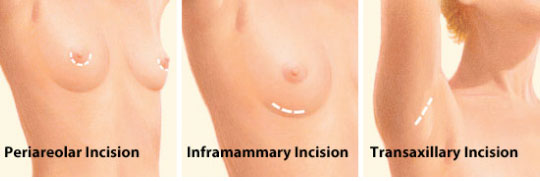The Different Incisions for Breast Augmentation
Women who choose to have breast augmentation surgery will be faced with several important decisions.
• Silicone or saline implants?
• Will the breast implant go above or below the muscle?
• What size implant?
• Which incision location is best?
There is not a right or wrong answer to any of these questions. Board Certified Plastic Surgeon’s will help their patients make the right choice dependent on what the patient’s goals are. The surgeon will explain the advantages and disadvantages of each.
Regarding the best choice for the location of the incision will depend on the goals of the patient and the preference and experience of the surgeon. Surgeons have their own preference as to which approach they use the most, however, if a patient has strong feelings about the location of the incisions; most surgeons can accommodate them. The main goal of the incision is to have it as invisible as possible with the least amount of complications.
There are three popular locations for insertion of breast implants:

1. The Periareolar Incision: The periareolar incision is a half-moon shape around the lower half of the areola. With the incision site so close to the placement of the implant, it is easier for the surgeon to control bleeding and make precise placement of the implant. Due to the change of color and texture of the areola, the incision heals to almost invisible. This incision will also allow easier access for possible future breast revision surgeries. The downside of this incision is a higher risk of sensation loss to the nipple, and milk ducts could be compromised making future breastfeeding problematic. In addition, the size of silicone implants may be limited.
2. The Inframammary Incision: This incision is located just above the breast fold; it is the most common approach. It gives the surgeon the most direct route for placement, and the least amount of surgery time. Also, post-operatively there is the least amount of swelling, as the breast gland is not cut. The scar is well hidden, so that if the woman is wearing a bathing suit the incision will not show if the top should ride up. This placement allows for the most options for implant sizes and the easiest access for future breast revision surgeries should they be necessary.
3. Transaxillary Incision: With this incision, the surgeon tunnels from the armpit, usually with an endoscope, to the breast. This will leave a small scar which may be visible when a woman raises her arm while wearing sleeveless garments. Saline implants are the easiest with this method as they are filled after insertion. Silicone implants, especially large ones, will have limitations. With the transaxillary approach, the surgery time is usually longer, and if breast revision is necessary for the future, a new incision site may be required.
There is a fourth option that some women request called the Trans-umbilical Breast Augmentation, also known as TUBA. This procedure remains somewhat controversial as the incision goes through the belly button; the advantage is that there is no visible scar.
However, only saline implants can be used. Dissecting the breast pocket is very challenging to get the optimal position, leading to higher rates of complications. When and if a breast revision surgery is needed, a new incision site may be required; however, there are some surgeons who specialize in this procedure.
Share Tweet
